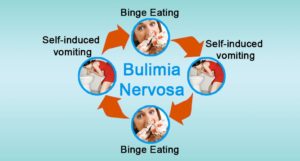Bulima Nervosa (Eating Disorder)
Buliimia Nervosa is a serious eating disorder that needs serious attention. I can’t attribute bulimia to someone who always eats when bored. I have a friend who’s got this sort of lifestyle but I don’t know if its entirely different from bulimia nervosa which is a mental disorder with serious complications.
People who suffer from this disorder (bulimia nervosa) use inadequate behaviours to impede fattening someone would eat just to induce vomiting.
A good number of girls of these days learn or listen to bulimic behaviour from their friends and before you know it, they end up practicing it themselves and the worst of it all; the external appearance does not show. This condition is also present in males.
A typical attributes of a bulimic person is that of a young woman or little girl who:
- Checks her weight and shape unrealistically. She may see herself deformed but in the actual sense she might be slightly overweight
- Eats to induce vomiting. Also uses other methods regarding overdose of laxatives, enemas, diuretics

Bulimia Nervosa is a life-threatening eating disorder. According to College of Medicine, University of Ibadan, it is reported that there’s over 100 thousand cases per year in Nigeria.
All involving bulimia nervosa are characterized by binge eating, accompanied by purging, excessive exercise and other efforts aimed at getting rid of fat or calories which includes the use of diuretics, stimulants etc.
Bulimia is associated with some mental illness or disorder like anxiety, depression and problems with alcohol and drugs.
Causes of Bulimia Nervosa
Some causes of bulimia may be traced to genetic factors according to Wikipedia and environmental factors. As stated earlier, bulimia behaviour may be learned or listened to, and those who do this may end up practicing it themselves and since the external appearance does not show in many cases, the disorder goes without being diagnosed. This also happens with anorexia nervosa.
The Risks of Bulimia
Aside the fact that 90% of those affected are women, they tend to be initiated into the practice by other bulimics who look normal and well adjusted. Bulimia has many other complications which includes:-
- Loss of dental enamel: Bulimia which is accompanied by frequent vomiting causes the enamel that covers the teeth to deteriorate
- Addiction: In bulimia, there’s presence of alcohol dependence.
- Depression: Here, depression is more common than in the general population.
How to Prevent Bulimia Nervosa
In order to prevent bulimia, some tips targeting two (2) areas must be followed. The first is internal which is targeted at thinking while the second is targeted to behaviour and to the environment where the person lives.

Inner Action (Thought)
It involves the following:
- Blaming oneself excessively should be curtailed. One does not need to suffer from the guilt of having eaten too much. One only needs to develop a plan to avoid the behaviour that produce guilt.
- One should not undervalue himself/herself. Just recognize your strength and set goals to improve your weakness. Have it at the back of your mind that others also have problems.
- Before meal, decide your intake: look out for a moderate and healthy diet. Condition your mind to believe that food is limited and there’s no more. This will help to avoid vomiting and purging

Outer Action involving behaviour and environment
- Avoid fast food most especially those loaded with fat, sweets, ice cream and other empty-calorie food. Therefore, eating rationally, try eating less amount more often.
- Try to escape stressful situations which trigger binge eating which we know is accompanied with vomiting and purging.
- Look for healthy people: Avoid those who use inadequate slimming methods and those who only value physical appearance
How to Treat Bulimia Nervosa
The most adequate treatment for bulimia is the clinical psychological treatment. This method of treatment involves the following:-
- The person learns to record one’s behaviour
- Develop action plans so as to improve self-esteem
- Discuss past conflicts
- Try to acquire good dietary habits
Another means is to substitute irrational and adverse thoughts with adaptive and useful thoughts so as to bring to remembrance an ongoing basis and moments of risks we well.
Anxiety and an Anxiety disorder
Anxiety and an Anxiety disorder

A graduate of Computer Science and Information Management Technology. Diploma – Caregiving, Certificates – Dementia and Diabetes Awareness and Management. A researcher, blogger, songwriter, singer and acoustic guitarist. Born in an environment where natural talents such as healing are imparted at our natural birth. This natural talents of healing is the result of our genetic inheritance and the training from family environment.











